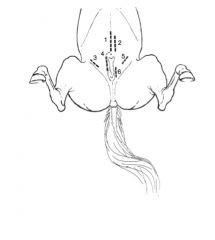![]()
![]()
![]()
Use LEFT and RIGHT arrow keys to navigate between flashcards;
Use UP and DOWN arrow keys to flip the card;
H to show hint;
A reads text to speech;
29 Cards in this Set
- Front
- Back
|
How often do propulsive contractions of the cecum and colon occur?
|
Every 3 to 4 minutes
|
|
|
What serum lactate level has been associated with a poor prognosis for horses with large colon volvulus? Paper? Year? Sensitivity/ specificity?
|
Greater than 6 mmol/L associated with poor prognosis per Vet Surg 2007, authors Johnstons et al. Lactate of < 6.0 mmol/L had 84% sensitivity and 83% specificity for predicting horse survival.
|
|
|
What is the association between GGT and right dorsal displacement?
|
Increase in GGT can occur in horses with RDD due to obstruction of the bile duct
|
|
|
What value of peritoneal fluid glucose is indicative of a septic process?
|
A difference greater than 50 mg/dL between the peripheral glucose and the peritoneal fluid glucose, or a peritoneal fluid glucose of < 30 mg/dL.
|
|
|
What peritoneal fluid pH is associated with septic peritonitis?
|
< 7.3
|
|
|
Where is the stomach visualized using ultrasonography?
|
Left abdomen, between 11th and 13th ICS
|
|
|
What colon wall thickness is associated with diagnosing LCV?
|
Greater than 9mm has a sensitivity of 67% and a specificity of 100% for detecting LCV
|
|
|
Where can right dorsal colitis be visualized?
|
R 10-14th ICS
|
|
|
What is the specificity and sensitivity for detecting enteroliths using computed radiography? Affects of gas? Affects of number of enteroliths?
|
85% sensitivity and 93% specificity for large colon. Sensitivity 50%, specificity 94% for small colon. Detection of enteroliths was significantly affected by the presence of gas distention but not by the number of enteroliths. JAVMA 2011 Maher et al.
|
|
|
What is the linea alba composed of?
|
Median fibrous raphe of the external oblique and the transverse abdominal muscle aponeuroses
|
|
|
What is the pattern of closure for ventral midline celiotomy?
|
Continuous pattern with loops placed 1.2-1.5 cm from the incisional edge
|
|
|
What size and suture are best for ventral midline celiotomy closure? Paper? Author?
|
PDS (polydioxanone) or vicryl (polyglactin 910.) 2005 Vet Surg Fierheller et al
|
|
|
Which procedures is a paramedian approach often chosen for?
|
Cystotomy, c-section, rupture bladder in foals, crypts, ovariectomy
|
|
|
What is the most common reason a paramedian approach is chosen?
|
Avoid previous linea alba incision
|
|
|
How do incisional complications from a paramedian approach compare with a ventral midline approach? Paper? Author?
|
Anderson et al, VS 2011, indicated incisional complications associated with ventral paramedian approaches compared favorably with ventral midline approaches. Complications occurred in 16.8% and included drainage in 15.5%, dehiscence in 3.7%, noticeable cutaneous scarring in 1.9%, and herniation in 0.6%.
|
|
|
What are the indications for an inguinal approach to the abdomen?
|
Cryptorchid castration or in combination with a ventral midline incision for reduction of a scrotal or inguinal hernia
|
|
|
What are the approaches to cryptorchid castration?
|
Inguinal, parainguinal and suprapubic approaches , as well as standing or recumbent laparoscopic approaches
|
|
|
What is the marcenac approach?
|
Low flank approach to the abdomen for c-section
|
|
|
What approaches are available for C-sections?
|
Ventral midline celiotomy which is further caudal than the traditional approach to the abdomen for abdominal exploration for colic or “marcenac”, a modified low flank approach
|
|
|
What approaches are used for nephrectomy?
|
An intercostal, at the level of the 15th or 16th ICS, and transcostal with rib resection, at the level of the 16th or 17th rib
|
|
|
Where is initial penetration on the abdomen made for laparoscopy surgery?
|
On the left side, without insufflation, to avoid iatrogenic damage to the cecum.
|
|
|
What is the laparoscopic approach to the abdomen?
|
½ way between the last rib and the tuber coxae just proximal to the dorsal border of the internal abdominal oblique muscle. Instrument portals are created 3 to 10 dorsal and ventral to the initial approach, based on trangulation.
|
|
|
What is the laparoscopic approach to nephrectomy?
|
Described in a 2001 Vet Surg paper, laparoscopic portal between the 17th and 18th rib, with instrument portals caudal to the 18th rib.
|
|
|
What is the initial laparoscopic approach for scope portal creation for dorsally recumbent horses and foals?
|
At the level of the umbilicus, except in foals where the portal is made 2 cm lateral to the umbilicus.
|
|
|
Where are instrument portal created for cryptorchetomy and herniorrhaphy?
|
10 cm lateral of midline and 10-15 cm cranial to the external inguinal ring
|
|
|
Where are the instrument portals created for ovariectomy?
|
1 each side 10 cm lateral to midline between the umbilicus and the mammary gland and 1 side, ½ way between the previous portal described and the mammary gland.
|
|
|
Where is the scope portal and instrument portal created for laparoscopic urolith removal?
|
Scope portal is created at the umbilicus and the instrument portal is placed 2-3 cm medial to the left external inguinal ring.
|
|

|

|
|

|

|

